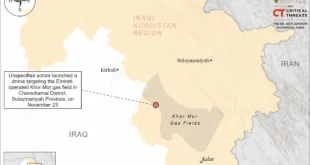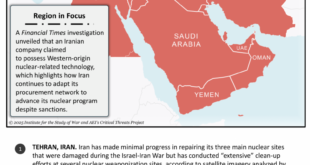- Lebanese Hezbollah and the Iran-backed Axis of Resistance more broadly, are attempting to restore deterrence after a series of high-profile Israeli attacks and operations.
- On Sunday morning, Israel struck targets in Lebanon in what it said was an attempt to pre-empt a major Hezbollah retaliation for the July 30 Israeli strike that killed the group’s top military commander, Fuad Shukr.
- Neither Israel nor Hezbollah have pledged that their Sunday escalations represent the end of their campaigns to achieve key strategic goals.
- Iran, the Houthi movement in Yemen, and other Axis partners are continuing to try to deter and pressure Israel and the United States but without triggering all-out war.
For many months after the October 7 Hamas attack on Israel, the region has stood on the knife-edge of an all-out regional conflagration that virtually all major stakeholders claim they want to avoid. As of April 2024, the potential for war to expand increased as Israel has sought to deal major blows to Iran and its proxies. A series of targeted Israeli strikes in Damascus, Beirut, and Tehran that killed senior Hamas, Hezbollah, and Islamic Revolutionary Guard Corps (IRGC) figures violated Iran’s and the Axis’ claimed “red lines.” Iran and its allies calculated they needed to restore a measure of deterrence against Israel by retaliating. In mid-April, Iran signaled it would take unprecedented action to deter Israel by launching a major missile barrage on Israeli cities, although the impact of the strike was thwarted by Israeli and U.S.-led defensive measures. At the same time, Iran and its allies all seek to avoid provocation to bring the full weight of U.S. military power to bear against them.
The prospects for all-out regional war heightened again early Sunday morning in the region, when U.S. and Israeli intelligence detected that Lebanese Hezbollah was preparing a significant escalation of missile and armed drone attacks. An unnamed U.S. official claimed that intelligence over the previous two days signaled that Hezbollah was about to carry out a large-scale attack on Israel. A Hezbollah strike would presumably represent retaliation for the July 30 Israeli attack on Beirut that killed the group’s top military commander, Fuad Shukr. That mission appeared intended not only to degrade Hezbollah’s command structure but also respond to the rocket strike that killed 12 Druze Arab children in the Israel-occupied Golan Heights city of Majdal Shams a few days earlier.
Consistent with its longstanding doctrine, Israel took pre-emptive action rather than absorb the brunt of a larger Hezbollah barrage. On Sunday morning, the Israeli military announced that “in a self-defense act to remove these threats, the [Israeli military] is striking terror targets in Lebanon, from which Hezbollah was planning to launch their attacks on Israeli civilians.” According to official statements, Israel sent 100 of its combat aircraft to strike more than 40 Hezbollah launch sites in southern Lebanon. The strikes reportedly primarily targeted Hezbollah’s longer-range missiles and launchers that could fire on central Israel. Israeli sources claimed their pre-emptive strike eliminated as many as 1,000 rocket and missile munitions at the 40 sites hit. Lebanon’s Health Ministry reported three deaths from the attack. Hezbollah reported two of them to be among its ranks.
The effect of the Israeli pre-emption was unclear from Hezbollah’s response, which consisted of a barrage of more than 230 rockets. Many of the rockets were intercepted by Israel’s Iron Dome and other defenses, and others landed in Israel but, according to the Israeli military, caused “very little damage.” Israel said on Sunday one military member was killed by a Hezbollah munition.
Hezbollah leader Hassan Nasrallah announced that the recent launch of what he claimed to be 240 Katyusha rockets targeted military bases in northern Israel, aiming to overwhelm the Iron Dome defense system so that Hezbollah’s drones could reach their targets. These targets included the headquarters of Unit 8200 and the Gilot base near Tel Aviv. However, Nasrallah stopped short of stating whether these targets were actually hit.
Since the October 7 Hamas attack, both Israel and Hezbollah have largely adhered to an unwritten understanding to limit their exchanges of artillery and rockets to areas close to the border. However, Israeli airstrikes have targeted locations further afield, including sites in Beirut and Hezbollah weapons stockpiles in its stronghold in the Bekaa Valley.
Also left unclear is whether the combat would continue to escalate or revert to the baseline of cross-border exchanges that have taken place since October 8. Hezbollah said it was standing down after the barrage, indicating the low Lebanese casualty count gave the group the opportunity to avoid further escalation. But, the group also stated its launches were a “first stage” of the group’s retaliation for the Shukr killing, adding the rest of its response to Shukr’s killing would take “some time.” Hezbollah Secretary-General Hassan Nasrallah further complicated the group’s messaging by saying the group is waiting to see the “results” of its attack before deciding on its next steps. He stated that if the group determined the results of its attack were “satisfactory,” then the retaliation for the killing of Hezbollah’s top commander Fuad Shukr will be considered concluded. But if not, the movement reserves the right to strike again at a later time, according to Nasrallah. He indicated that Iran and its allies decided not to launch a coordinated attack but instead chose to strike back against Israel separately.
Israel’s leadership also left its intent and the trajectory of its ongoing actions unclear, perhaps setting the stage for further Israeli strikes. In a statement on Sunday, Israeli Prime Minister Binyamin Netanyahu said: “What happened today is not the end of the story.” Suggesting Israel’s purportedly pre-emptive attack might be part of a broader effort to compel Hezbollah to retreat, Netanyahu added: “Nasrallah in Beirut and Khamenei in Tehran should know that this is another step on the way to change the situation in the north and return our residents safely to their homes…And I repeat – this is not the end of the story.”
The statement suggested Israel might undertake additional extensive attacks on Hezbollah military assets in an effort to compel Hezbollah to withdraw its forces north of the Israel-Lebanon border. For months, Israel has threatened escalation against Hezbollah if it refuses to move forces off the border. Israel insists that a Hezbollah pullback is necessary in order for 80,000 Israelis who have left their northern villages to return to their homes. Separate from the ongoing negotiations on a ceasefire in the Gaza conflict, U.S. officials have been seeking to de-escalate Israel-Hezbollah conflict by working with French and other officials to persuade Hezbollah to move its elite forces at least six miles north of the border. They have argued that U.N. Security Council Resolution 1701, which ended the destructive Israel-Hezbollah war in 2006, requires Hezbollah to do so.
The broader Iran-led Axis is also attempting to calibrate its plans to deter Israel and press Israel to accept a Gaza ceasefire, but without triggering a broad war that might bring them into direct and sustained combat with the United States. Iran has vowed to respond to the July 31 killing in Tehran, by Israeli operatives, of Hamas’ top leader Ismail Haniyeh. For now, Tehran has appeared content to delegate its response to its Axis partners, particularly Hezbollah. Iran has not, to date, retaliated directly for the Haniyeh killing, despite insisting it would do so in order to restore deterrence against Israel. Nor did Tehran join Hezbollah’s response to the Israeli pre-emptive air strikes on Sunday.
The one Axis partner that has appeared undeterred from repeatedly crossing U.S. and global red lines is the Houthi movement of Yemen. Despite repeated U.S.-led strikes on their missile arsenal and other military infrastructure over the past six months, the Houthis continue to attack commercial shipping in the Red Sea, a major chokepoint in the region. In so doing, the Houthis are challenging the centuries-old U.S. commitment to defend the freedom of navigation and of global commerce.
Last week, the Houthis conducted a direct seaborne attack on the oil tanker MT Delta Sounion, setting the ship ablaze and forcing its crew to abandon the vessel to a rescue by a French warship. A U.S. statement said the attack threatens “to spill a million barrels of oil into the Red Sea, an amount four times the size of the Exxon Valdez disaster. While the crew has been evacuated, the Houthis appear determined to sink the ship and its cargo into the sea. Through these attacks, the Houthis have made clear they are willing to destroy the fishing industry and regional ecosystems that Yemenis and other communities in the region rely on for their livelihoods, just as they have undermined the delivery of vital humanitarian aid to the region through their reckless attacks…”
Despite the threat presented by the Houthis, who have also conducted at least one fatal armed drone attack on Israel, U.S. and allied officials have not, to date, identified a combination of military and diplomatic steps to end the Houthi campaign. The Houthis have stated that only an end to the Gaza war will suffice to meet their conditions for ending their assaults. The group does not seem to fear the United States is willing to exert the necessary military pressure that would be needed to deter the group from further attacks.
 Eurasia Press & News
Eurasia Press & News



